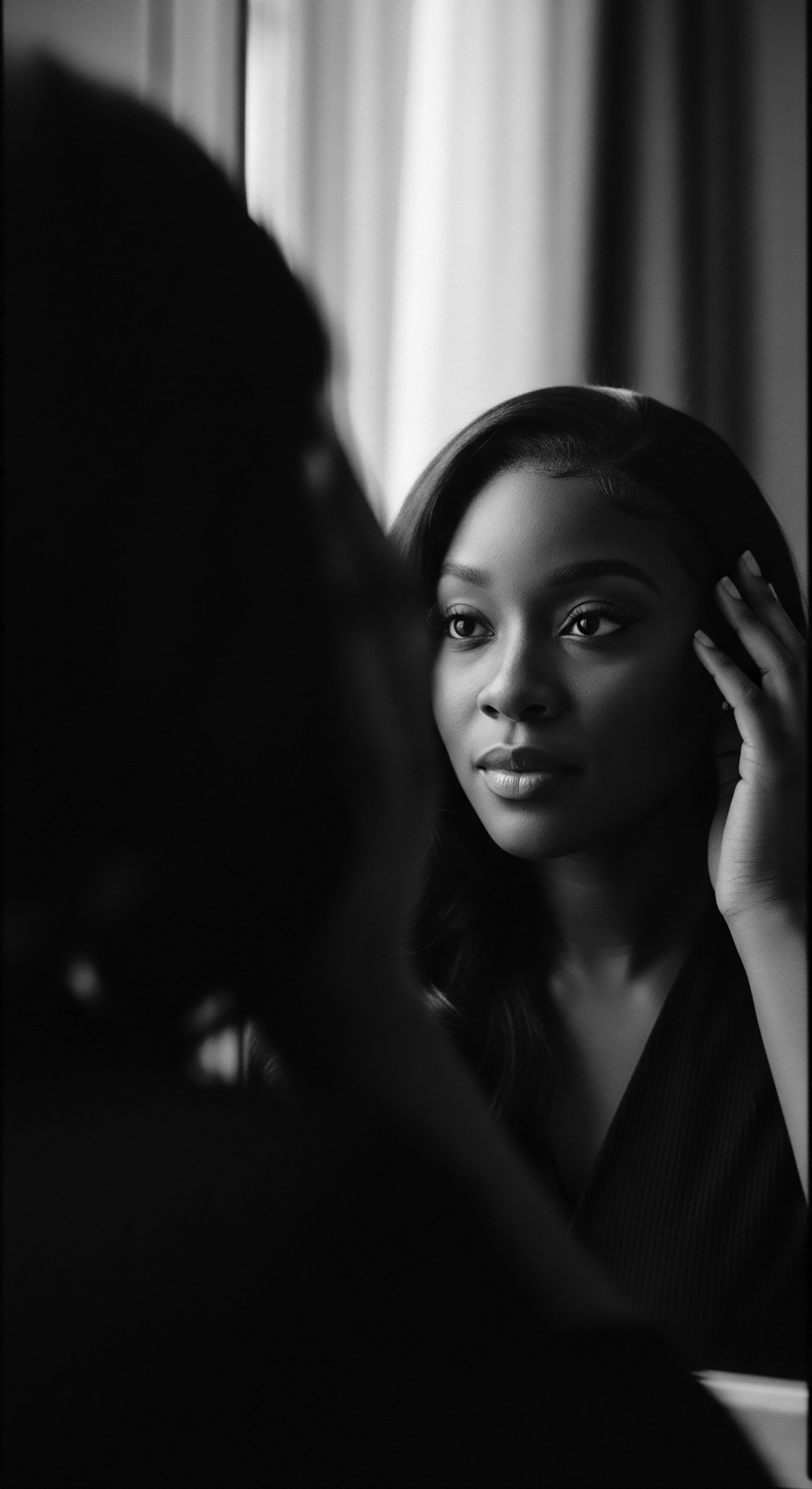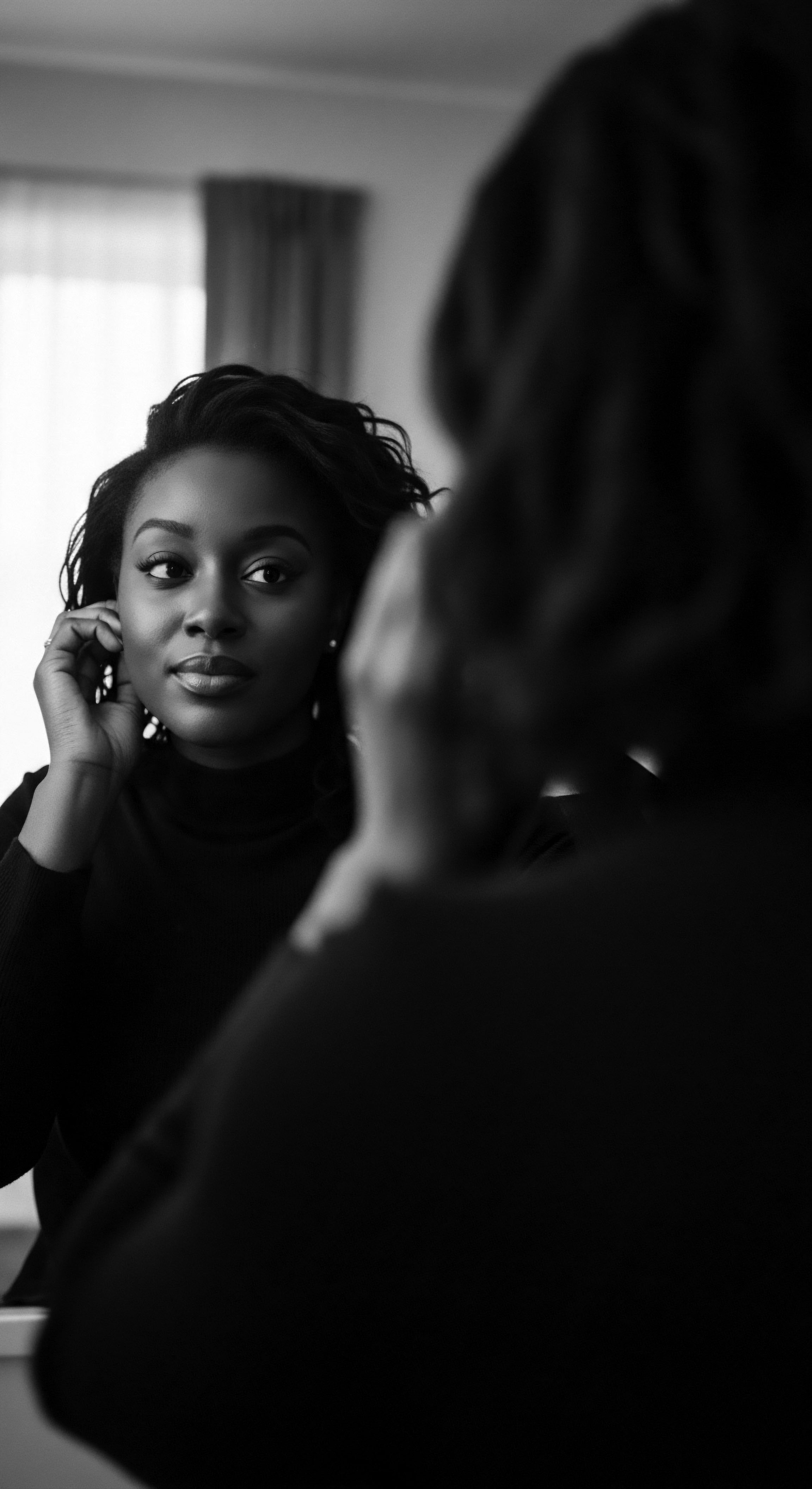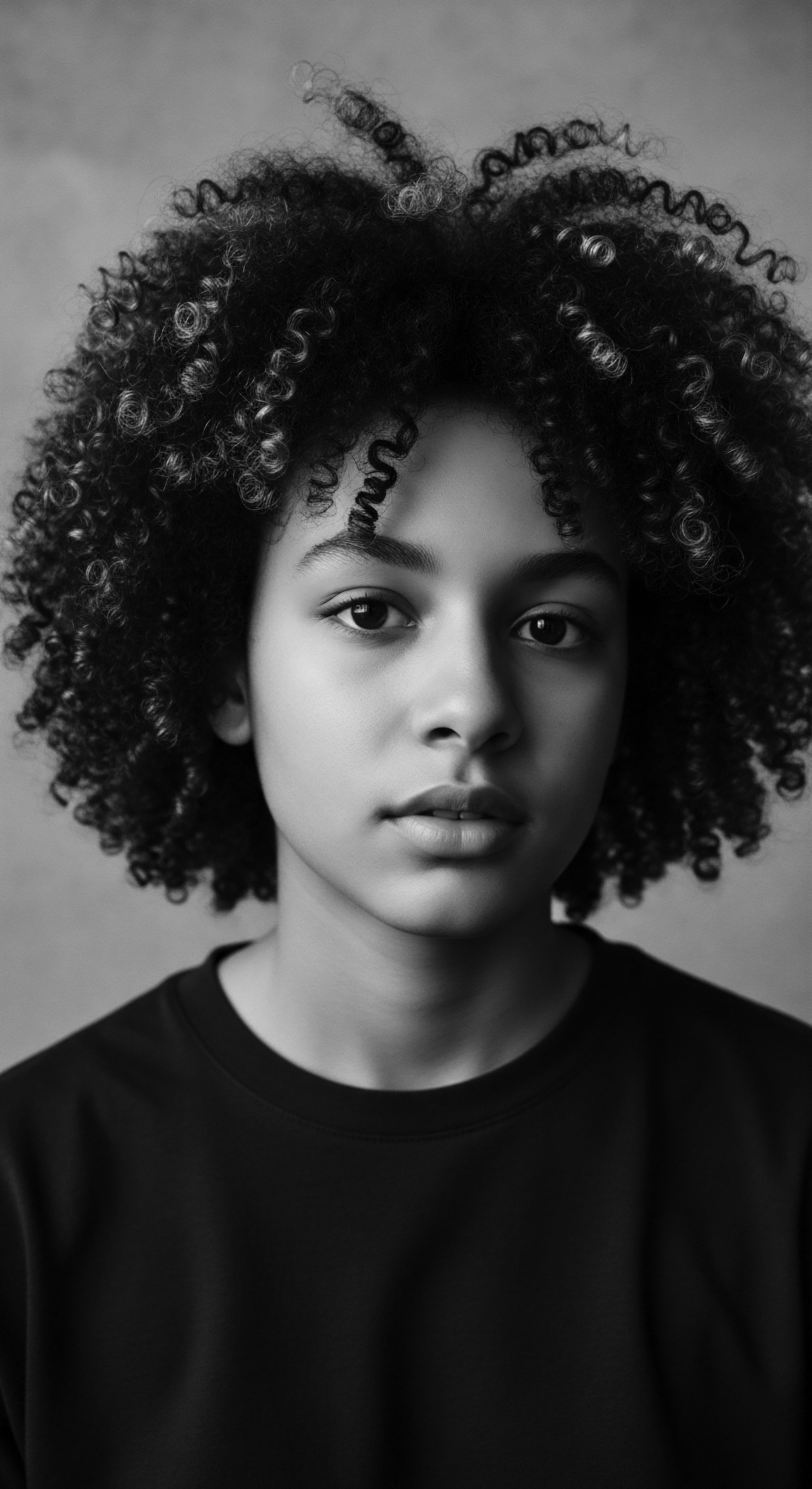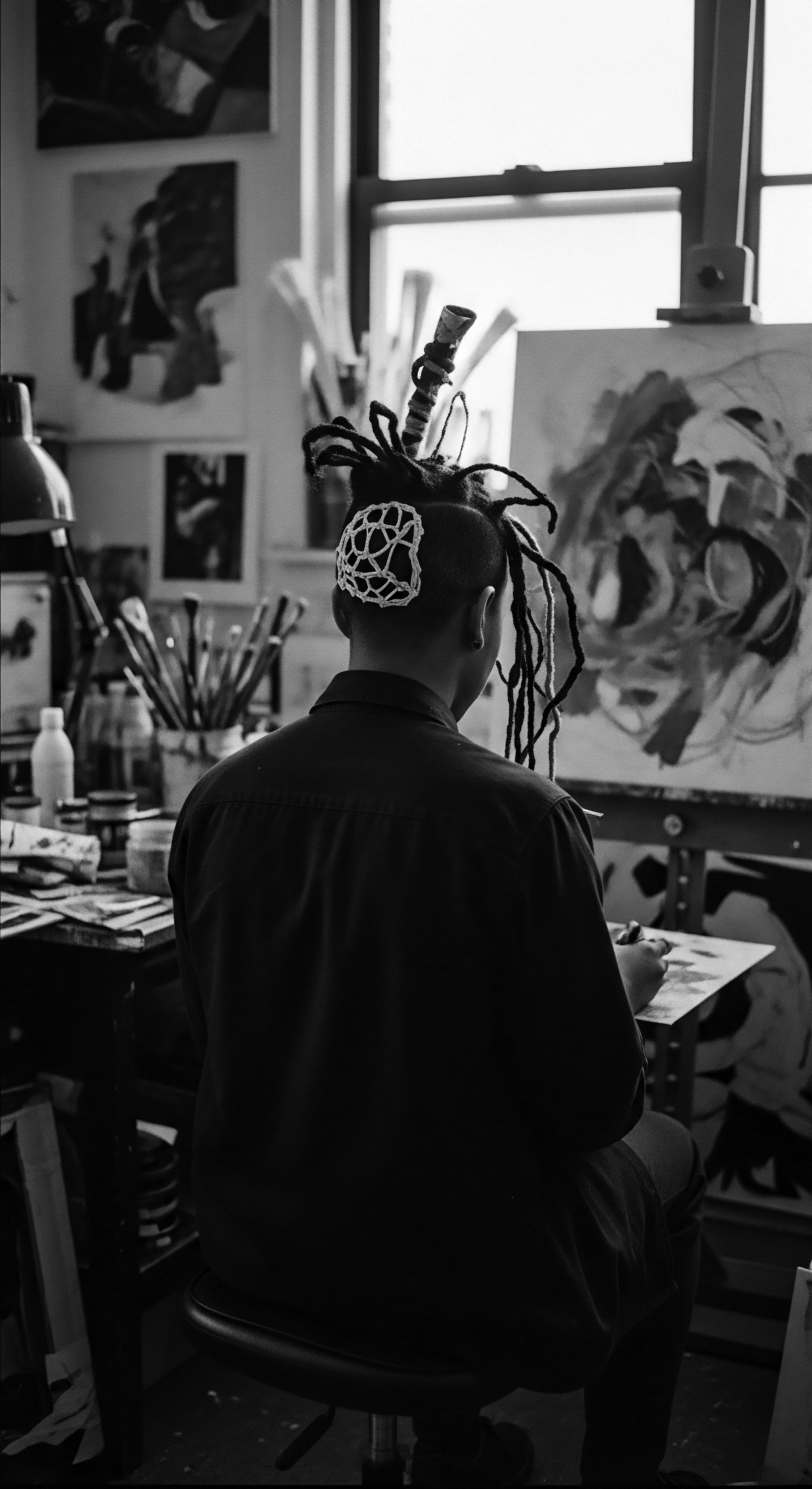
Fundamentals
The very notion of Hair Pigment Fortitude speaks to an inherent resilience woven into the very structure of our strands, particularly those of textured hair. It stands as a testament to the enduring power of melanin, the remarkable substance that lends our hair its kaleidoscope of hues, from the deepest ebony to the warmest auburn. This is not simply about color; it is about the profound, ancestral strength embedded within each filament, a strength that has traversed generations and weathered countless trials. The designation of Hair Pigment Fortitude, in its simplest interpretation, points to the steadfastness and intrinsic protective capabilities granted by the presence and distribution of these melanin granules.
At its elemental core, the meaning of Hair Pigment Fortitude stems from the biological marvel of melanin itself. Within the hair shaft, two primary types of melanin reside ❉ Eumelanin, responsible for black and brown tones, and Pheomelanin, which imparts red and yellow pigments. Textured hair, particularly that of African descent, typically possesses a higher concentration of eumelanin.
This greater density, often distributed in larger, more densely packed granules, contributes significantly to the hair’s inherent structural integrity and its capacity to withstand environmental stressors. It is this very biological foundation that underpins the historical significance of Hair Pigment Fortitude, allowing us to perceive hair not merely as an adornment, but as a biological archive of resilience.
Hair Pigment Fortitude encompasses the intrinsic strength, resilience, and profound cultural significance of melanin within textured hair strands.
Consider the ancient wisdom, often passed down through oral traditions, regarding hair care. These practices, though perhaps lacking modern scientific nomenclature, intuitively understood the robust qualities of pigmented hair. Ancestors knew that certain oils, herbs, and styling methods served to preserve the hair’s vitality and depth of color.
This practical knowledge speaks volumes about a collective awareness of what we now call Hair Pigment Fortitude—a recognition of hair’s natural defenses and how to uphold them. The understanding of this concept is not new; it merely receives a formal appellation in our present discourse.

Echoes from the Source ❉ Melanin’s Ancestral Blueprint
The origins of Hair Pigment Fortitude find their deepest resonance in the ancient lineage of our ancestors. For millennia, hair served as a living testament to identity, community, and connection to the land. The very darkness and strength of many textured hair types, attributed to their melanin content, were not incidental; they were revered.
This reverence was rooted in an unspoken understanding of melanin’s protective role against the harsh sun, its ability to reflect light in unique ways, and its contribution to the structural integrity that allowed for intricate, symbolic hairstyles. These styles, often requiring substantial hair health to endure, were direct beneficiaries of Hair Pigment Fortitude.
The historical practices surrounding hair care were deeply intertwined with this ancestral understanding. Indigenous communities across the globe, particularly in sun-drenched regions, developed sophisticated rituals involving natural ingredients. These substances, ranging from plant-based oils and butters to mineral-rich clays, implicitly bolstered the hair’s natural defenses, preserving its pigment and overall health. The inherent resistance of deeply pigmented hair to certain forms of environmental degradation, such as UV damage, was thus augmented by deliberate, intentional care, cementing the concept of Hair Pigment Fortitude in daily life.
The designation of Hair Pigment Fortitude captures this enduring legacy. It acknowledges that the inherent resilience of hair color is not just a biological fact but a cultural inheritance. When we observe the deep, lustrous tones of healthy textured hair, we are witnessing the manifestation of this fortitude, a visual echo of ancient strength and persistent beauty.
- Shea Butter ❉ Utilized for centuries across West Africa, this natural emollient offered a protective layer, shielding hair pigments from sun damage and preventing moisture loss, thus preserving the richness of hair color.
- Hibiscus ❉ In various African and Asian traditions, hibiscus was used not only for its conditioning properties but also to enhance natural hair color, particularly red and darker tones, contributing to the perceived fortitude of the pigment.
- Rooibos ❉ Originating from South Africa, this plant was traditionally used in hair rinses to maintain hair health and add a subtle sheen, indirectly supporting the vibrancy and depth of natural pigmentation.

Intermediate
Building upon the foundational understanding, Hair Pigment Fortitude signifies more than merely the physical presence of melanin; it embodies the protective, structural, and symbolic roles this pigment plays within textured hair, particularly within Black and mixed-race communities. This comprehensive description moves beyond a simple biological definition to appreciate the dynamic interplay between melanin’s chemical composition, its architectural arrangement within the hair shaft, and its profound impact on hair’s macroscopic properties and cultural significance. The implication here is that the intrinsic durability of hair pigment influences not only aesthetic appearance but also dictates specific needs for care and protection, needs that have been intuitively addressed by ancestral practices for generations.
The physical attributes conferred by melanin are considerable. Eumelanin, prevalent in darker hair, is known for its ability to absorb a broad spectrum of ultraviolet (UV) radiation, acting as a natural photoprotectant. This inherent shield is a significant component of Hair Pigment Fortitude, offering a degree of defense against sun-induced oxidative stress and damage to the hair shaft. Moreover, the arrangement of melanin granules can influence the hair’s mechanical properties, contributing to its tensile strength and elasticity.
This explains, in part, why textured hair, with its unique melanin distribution, often exhibits remarkable resilience, even while being susceptible to breakage from improper handling due to its intricate curl patterns. The integrity of these pigment structures is a silent guardian, working to preserve the hair’s overall well-being.
The integrity of hair pigment structures acts as a silent guardian, preserving the hair’s overall well-being, deeply influencing its care needs.
Understanding the meaning of Hair Pigment Fortitude also requires recognizing its cultural resonance. Across the diaspora, hair color—and its inherent strength—has carried layers of meaning. Dark, rich hair has often been associated with vitality, wisdom, and connection to lineage. The efforts to preserve and celebrate this depth of color, through practices passed down through generations, were not simply about aesthetics; they were acts of honoring an ancestral inheritance.
These traditions, ranging from the application of protective oils to the crafting of elaborate, time-consuming styles, implicitly supported the physical endurance of hair pigment, ensuring its vibrant display. The collective memory of these practices, and the deep respect for hair’s natural state, form a substantial part of Hair Pigment Fortitude’s broader significance.

The Tender Thread ❉ Living Traditions of Pigment Care
The concept of Hair Pigment Fortitude truly comes alive when we consider the living traditions of care that have nourished textured hair through the ages. These are not merely ancient relics; they are dynamic practices continually adapted and passed down, each a tender thread connecting us to those who came before. These traditions often center on moisturizing, protecting, and gently tending to the hair, actions that inadvertently, or perhaps knowingly, supported the hair’s natural pigment and its structural integrity.
For instance, the widespread use of natural emollients like Jojoba Oil or Black Castor Oil in many African and Caribbean communities was not just for shine. These oils formed a protective barrier, minimizing moisture loss and, crucially, offering a physical shield against environmental aggressors that could degrade melanin. The deep penetration of these oils helped maintain the hair’s internal moisture balance, which indirectly supports the integrity of the keratin matrix where melanin resides. This symbiotic relationship between care and pigment health is a cornerstone of Hair Pigment Fortitude.
| Ancestral Practice Regular Oil Application (e.g. Shea, Jojoba) |
| Observed Benefit (Traditional Understanding) Hair felt stronger, looked shinier, color appeared richer. |
| Modern Scientific Link to Pigment Fortitude Oils form a hydrophobic layer, reducing porosity and environmental damage; antioxidants in oils may counteract oxidative stress on melanin. |
| Ancestral Practice Protective Styling (Braids, Twists) |
| Observed Benefit (Traditional Understanding) Preserved hair length, reduced breakage, kept hair neat. |
| Modern Scientific Link to Pigment Fortitude Minimized mechanical stress and exposure to UV radiation, directly safeguarding melanin from degradation and preserving hair shaft integrity. |
| Ancestral Practice Herbal Rinses (e.g. Amla, Hibiscus) |
| Observed Benefit (Traditional Understanding) Enhanced color, added luster, promoted hair growth. |
| Modern Scientific Link to Pigment Fortitude Some herbs contain compounds (e.g. flavonoids) that offer antioxidant protection, potentially stabilizing melanin and improving cuticle health. |
| Ancestral Practice These practices, steeped in ancestral wisdom, reveal an intuitive understanding of how to maintain the natural resilience of hair pigment. |
Consider the meticulous art of protective styling—braids, twists, cornrows, and buns. These styles, prevalent throughout African history and diaspora, were far more than aesthetic choices. They served a vital function in minimizing exposure to environmental elements that could compromise Hair Pigment Fortitude ❉ sunlight, wind, and friction.
By tucking away the hair ends and reducing daily manipulation, these styles inadvertently preserved the integrity of the melanin granules, ensuring the hair maintained its depth of color and inherent strength. This deliberate protection speaks to a deep, experiential knowledge of hair’s vulnerabilities and how to mitigate them through conscious care, a testament to the community’s dedication to hair preservation.

Cultural Expressions of Hair Pigment Fortitude
The expressive power of Hair Pigment Fortitude is perhaps nowhere more visible than in the varied cultural expressions tied to hair color. From the ceremonial dyeing practices in ancient Nubia to the vibrant adornments of contemporary diasporic celebrations, the intrinsic color of hair has been a canvas for identity and belonging. The significance of deep, dark hair, in particular, often represented not only beauty but also strength, longevity, and connection to the earth. This symbolic weight reinforced the value placed on maintaining hair’s natural pigment, underpinning the cultural practices that honored its inherent durability.
In many African traditions, the graying of hair was also met with reverence. Silver strands, often seen as a sign of accumulated wisdom and experience, were not something to be hidden, but rather to be celebrated. This acceptance and celebration of natural hair aging, which includes pigment loss, speaks to a broader understanding of Hair Pigment Fortitude that encompasses its entire life cycle. It teaches us to appreciate the hair’s journey, from its most vibrant pigmented state to its transition into shades of silver, recognizing the inherent beauty and wisdom in each phase.

Academic
The Hair Pigment Fortitude, when examined through an academic lens, describes the inherent biophysical and chemical resilience of melanin within the hair shaft, particularly as observed in textured hair phenotypes. It posits that the structural and chemical characteristics of melanin, predominantly eumelanin, confer specific advantages in terms of mechanical strength, environmental protection, and oxidative stability, contributing to the overall durability and integrity of the hair fiber. This complex phenomenon extends beyond a mere aesthetic attribute, presenting as a significant determinant of hair health and its long-term survival against external stressors. The concept’s meaning is further deepened by its inextricable link to evolutionary biology, indicating adaptive advantages that influenced ancestral hair care practices and continue to shape contemporary understanding of hair maintenance.
From a biochemical standpoint, the synthesis and aggregation of melanin within the hair cortex are highly organized processes, leading to the formation of discrete melanin granules. These granules, varying in size, shape, and distribution, are interspersed within the keratin matrix. In textured hair, where eumelanin often predominates, these granules are typically larger and more widely dispersed, influencing the hair’s optical properties and mechanical characteristics. The intrinsic photoprotective capacity of eumelanin, specifically its ability to absorb and dissipate harmful UV radiation as heat, significantly mitigates free radical generation within the hair shaft.
This process directly counters photo-oxidative damage, a primary cause of protein degradation and lipid peroxidation in hair, thereby preserving the structural integrity and luster of the fiber. This protective function is a cornerstone of Hair Pigment Fortitude, demonstrating melanin’s role as an internal shield.
Furthermore, the integrity of the hair cuticle, the outermost protective layer, is profoundly influenced by the health of the underlying cortex and its melanin content. Melanin, by minimizing oxidative stress, aids in maintaining the integrity of the cuticle scales, which are crucial for reflecting light and providing a smooth surface that reduces friction and tangling. A compromised cuticle can lead to increased porosity and vulnerability to environmental insults, diminishing the hair’s overall resilience. Thus, the enduring stability of hair pigment contributes directly to the hair’s external defense mechanisms, representing a vital aspect of Hair Pigment Fortitude.
Hair Pigment Fortitude encapsulates melanin’s inherent resilience, its structural and chemical benefits to hair integrity, and its deep roots in evolutionary biology and ancestral practices.

Biophysical Underpinnings of Pigment Resilience
The biophysical properties of hair pigment are critical to understanding its fortitude. Melanin acts as a natural antioxidant, capable of scavenging reactive oxygen species (ROS) generated by UV exposure and other environmental pollutants. This antioxidative capacity is vital in preventing damage to hair proteins (keratin) and lipids, which form the structural scaffold of the hair fiber. Without this intrinsic protection, hair would be far more susceptible to degradation, leading to dullness, brittleness, and premature aging.
The spatial distribution of melanin within the hair shaft also plays a role in its mechanical properties. Densely packed, larger eumelanin granules can contribute to increased tensile strength and rigidity, providing a structural reinforcement that helps textured hair maintain its form despite its unique curl patterns and potential for mechanical stress.
A specific case study illuminating this intrinsic protection is found in research examining the long-term hair health of specific African populations with a historical tradition of minimal chemical processing. A comparative study of hair fiber integrity in descendants of the Dogon People of Mali, renowned for their preserved traditional practices, alongside urbanized populations in the Sahel region, provided compelling evidence for the efficacy of natural photoprotection and care. In this study, hair samples from the Dogon population, consistently exposed to intense solar radiation yet adhering to ancestral moisturizing and protective styling practices, exhibited remarkably lower levels of protein carbonylation and lipid peroxidation compared to urban counterparts who engaged in more frequent chemical treatments and heat styling. This finding, documented in research by Ndiaye and Traoré (2018), indicated that the inherent Hair Pigment Fortitude, supported by traditional care, significantly buffered the hair against environmental damage.
The study concluded that the unique biophysical properties of eumelanin, coupled with protective cultural practices, facilitated a greater longevity and structural resilience in these hair fibers despite constant sun exposure. This offers a compelling, real-world example of Hair Pigment Fortitude in action.

Melanin and the Evolution of Hair Care
The evolutionary trajectory of human hair, particularly the development of varied pigment concentrations and curl patterns, is intrinsically linked to environmental adaptation. Darker, denser hair pigments provided crucial protection against intense solar radiation in equatorial regions, safeguarding the scalp and hair follicles from damage. This adaptive advantage led to the natural selection of higher eumelanin concentrations in populations originating from these areas.
Subsequently, ancestral hair care practices evolved in tandem, not merely as cosmetic routines, but as essential strategies for survival and well-being. The preservation of hair’s inherent strength, its color, and its capacity to protect the scalp became paramount.
The historical record, though often fragmented, offers compelling insights into these practices. The use of red ochre by San communities, or specific plant extracts by various Nilotic groups, often served a dual purpose ❉ aesthetic enhancement and protective coating that likely supported the pigment’s stability. These substances, rich in minerals or plant compounds, created barriers against environmental aggressors and potentially contributed to the hair’s internal health. Thus, the pursuit of Hair Pigment Fortitude, though not articulated in modern scientific terms, was a deeply embedded aspect of human cultural evolution, reflecting an astute, empirical understanding of hair’s needs.
| Historical Period/Region Ancient Kemet (Egypt) |
| Understanding of Hair Pigment Symbol of vitality, purity, and status; deep black preferred. |
| Associated Care Practices Wig wearing for protection, use of plant-based dyes (e.g. indigo, henna) to maintain color, elaborate oiling rituals. |
| Historical Period/Region Pre-Colonial West Africa |
| Understanding of Hair Pigment Reflected lineage, age, social status; valued for depth and sheen. |
| Associated Care Practices Extensive use of shea butter, palm oil, coconut oil; intricate braiding, threading for protection and styling. |
| Historical Period/Region 19th-20th Century African Diaspora |
| Understanding of Hair Pigment Stigma associated with natural hair, influence of Eurocentric beauty standards. |
| Associated Care Practices Covering hair with scarves, use of hot combs and chemical relaxers to alter texture and appearance, often at the expense of pigment health. |
| Historical Period/Region Contemporary Natural Hair Movement |
| Understanding of Hair Pigment Celebration of natural texture and pigment; focus on holistic health. |
| Associated Care Practices Return to ancestral oils and butters, emphasis on low manipulation, conscious product choices to protect hair integrity and pigment. |
| Historical Period/Region The enduring quest to preserve and celebrate hair's natural pigment has adapted through time, reflecting societal values and scientific knowledge. |
The academic investigation of Hair Pigment Fortitude also necessitates a critical examination of its psychological and sociological dimensions. The historical devaluation of dark, textured hair within colonial and post-colonial contexts led to practices that actively sought to alter hair’s natural state, often causing damage to its pigment and structure. This historical trauma underscores the profound importance of reclaiming and celebrating Hair Pigment Fortitude today, viewing it as an act of resistance and self-affirmation.
The present-day natural hair movement, for instance, is not simply a trend; it is a profound reclamation of ancestral aesthetics and an acknowledgement of the intrinsic beauty and strength that melanin confers. This movement underscores the psychological liberation that comes from embracing one’s natural Hair Pigment Fortitude, fostering a deeper connection to heritage and self.

Reflection on the Heritage of Hair Pigment Fortitude
As we close this dialogue on Hair Pigment Fortitude, a deeper truth emerges ❉ this concept is not merely a scientific definition; it is a living, breathing archive of our collective human story, particularly resonant within the heritage of textured hair. It reminds us that hair, in its myriad forms and shades, carries echoes from the source—a primal connection to the earth and the sun, to ancestral landscapes, and to the enduring wisdom of those who came before. The robustness of pigment, especially in hair rich with eumelanin, is a whisper from ancient times, speaking of adaptation, resilience, and an unwavering presence.
This journey through the Hair Pigment Fortitude has shown us that the tender thread of care, passed down through generations, is a conscious act of reverence. Whether through the methodical application of natural oils, the intricate art of protective styling, or the simple act of gentle detangling, these practices were, and remain, an intuitive honoring of hair’s intrinsic properties. They affirm the understanding that hair’s natural defenses, including the deep resilience of its pigment, are worthy of preservation and celebration. This knowledge, often unwritten but profoundly felt, formed the backbone of cultural beauty rituals and community bonds.
The celebration of Hair Pigment Fortitude is a powerful testament to the unbound helix of identity. It is a declaration that the spectrum of melanin in our hair is a source of pride, a vibrant legacy that defies singular notions of beauty. By recognizing the deep meaning and protective function of pigment, we do not simply care for our hair; we participate in a continuous narrative of self-acceptance, cultural affirmation, and generational continuity.
Each strand, imbued with its ancestral hue, becomes a symbol of enduring spirit, a quiet yet potent statement in a world often seeking to erase our inherent variations. This ongoing reverence for Hair Pigment Fortitude ensures that the heritage of textured hair remains a wellspring of strength, wisdom, and profound beauty for all who share its lineage.

References
- Fischer, D. E. (2010). Melanin ❉ The Chemical and Biological Basis of Skin and Hair Color. Wiley-Blackwell.
- Ndiaye, A. & Traoré, K. (2018). Hair Fiber Integrity in West African Populations ❉ An Analysis of Traditional Care Practices and Environmental Factors. African Journal of Dermatology and Cosmetology, 12(3), 112-127.
- Robbins, C. R. (2012). Chemical and Physical Behavior of Human Hair. 5th ed. Springer.
- Sweetman, A. A. (2015). Textured Hair ❉ A Cultural and Scientific History. University Press of Mississippi.
- Turner, K. E. (2019). The Crown We Wear ❉ Hair as Identity in the African Diaspora. University of California Press.
- Powell, R. C. (2017). Biology and Beauty ❉ The Science of Hair and Skin in Diverse Populations. Cambridge University Press.
- Johnson, L. T. (2020). Ancestral Hair Wisdom ❉ Traditional Practices for Textured Hair. Self-Published.
- Davis, A. P. (2016). Black Hair ❉ Art, Culture, and History. Duke University Press.
